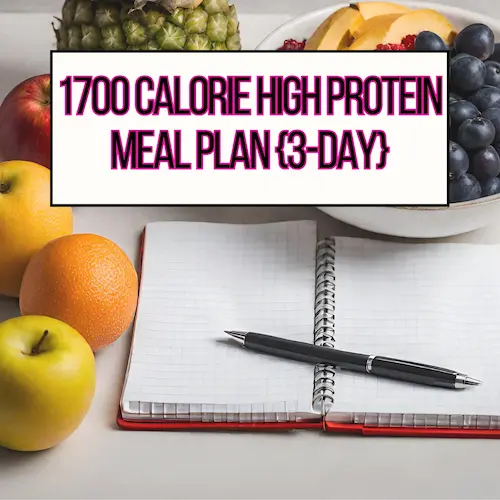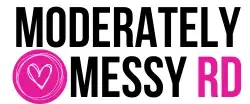Striking the right balance of calories and protein can have many long-term advantages – whether your goal is to lose or maintain weight. Protein is the key macronutrient in making positive changes to body composition. Use this 3-day 1700-calorie high protein meal plan as inspiration, and customize based on your lifestyle and preferences.

This meal plan was developed to give you an idea of what it looks like to consume 1700 calories per day while prioritizing protein. Let’s discuss the link between protein and weight management, calorie and protein needs, as well as simple ways to increase overall protein intake!
Figuring Out Calorie Needs
Calorie needs can be affected by a number of factors – and it’s difficult to determine those needs with 100% accuracy. However, a good “estimate” can be helpful with weight management.
The below image uses the Harris-Benedict equation to figure out an estimation of your daily caloric needs – much like the calculators you’ll find online. If your goal is to lose weight, subtract 300-500 calories (but I don’t recommend anything lower than 1500 calories per day).

So, for a 35-year old, 150-pound lightly active female, her calorie needs would be about 2,100 per day. For a weight-loss of about one-pound per week, that’s 1600-1700 calories.
The Link Between Protein and Weight Management
Several clinical studies have found that consuming more than the recommended daily allowance of protein can help to reduce body weight and decrease fat mass. It can even help prevent weight regain after weight loss.
If you’re in a calorie deficit, consuming a diet higher in protein preserves lean muscle mass – which helps to maintain or increase the number of calories we burn at rest.
When compared to carbohydrates and fats, protein takes the longest to digest- and therefore keeps us fuller for a longer period of time. Therefore, meals high in protein could potentially lead to less overall caloric intake.
How Much Protein Should We Consume Each Day?
This is a highly debatable topic. While the recommended allowance suggest 0.8 grams per kilogram per day – this is just the minimum amount we need to prevent loss of lean muscle mass. For active, healthy adults, it is more ideal to consume 1.2-1.7 grams per kilogram per day! For a 150-pound person, this is 82-116 grams per day.
Even further, most research has shown that it is best to distribute protein evenly throughout the day for muscle protein synthesis, digestion and absorption. This means that consuming 40 grams or more at one meal might not be as beneficial. However, a recent study examined eating more than the recommended 20-30 grams of protein per meal and found that this may not be the case anymore.
1700-Calorie High Protein Meal PLan
In an ideal world, a 1700 calorie high protein meal plan would consist of at least 3 meals daily ranging from 400-500 calories each with at least 25 grams of protein. Plus, 1-2 snacks.
This meal plan does not take into account carbohydrates, but meal plan #3 is a lower carb option. The latest research shows a diet with less than 130 grams of carbs per day is just as effective as a keto diet. It’s not necessary to follow a restrictive diet like keto for long-term weight loss goals!
Nutritional information is just an estimation. Using a meal tracking app can be helpful when tracking calories – and hopefully, with time, you’re a pro at building healthy meals high in protein and fiber and forget all about calorie counting!
Meal Plan #1: 1,715 Calories, 114g protein

Breakfast: Chia Breakfast Bowl with 8-ounce coffee with 1 Tbsp. cream (415 calories, 22g protein). This chia breakfast bowl is packed with protein and fiber – both which can be beneficial for weight management and stabilizing blood sugars. The bowl consists of Greek yogurt (which has up to 15 grams of protein per 1/2 cup), chia seeds, topped with nuts and fruit.
Lunch: Grilled Chicken Salad by Dinner at the Zoo (480 calories, 23g protein). A light and easy chopped chicken salad – 4 ounces of chicken breast contains about 25 grams of protein per serving.

Dinner: Parmesan Crusted Cod by Haute & Healthy Living + 1/2 cup of rice (400 calories, 28g protein).
Snacks: Chocolate Cheesecake Protein Pudding topped with 1 Tbsp. whipped cream (219 calories, 36g protein) + Apple Slices and 1 Tbsp. Peanut Butter (190 calories, 5g protein)

This meal plan leaves 420 calories left for snacks! There is plenty of room to customize each meal, or have a more indulgent treat.
Meal Plan #2: 1,703 Calories, 97.5g protein
Breakfast: Egg and Cheese Burrito (510 calories, 28g protein). Nutritional estimation based on 2 eggs scrambled, 12″ high-fiber tortilla, 1/2 avocado, and 1/4 cup shredded cheese.
Lunch: Tuna Salad from Culinary Hill on Low-Carb Bread (415 calories, 25g protein).
Dinner: Tofu Rice Bowl with Greek Yogurt Bang Bang Sauce (478 calories, 35.5g protein). A high-protein, plant-based dinner option – which can be hard to find! Adding Greek yogurt to the sauce helps to increase the protein content. If you’re not sure about tofu, this recipe ensure they’re nice and crispy for a more palatable texture.

Snack: 3 Oreos with 8-ounce glass of skim milk and 1/2 cup of strawberries (300 calories, 9g protein)
The meals in this meal plan are a little higher in calories, leaving room for one larger snack (or two smaller ones).
Meal Plan #3: 1,703 calories, 122g protein
Breakfast: 3 Kodiak Cake pancakes with 1/2 cup of Greek yogurt and 2 Tbsp. maple syrup with 8-ounce glass of milk (490 calories, 36g protein). Combining the Greek yogurt and maple syrup creates a creamy, high protein topping for the pancakes. Pro-tip: compare the labels of different brands of pancakes and waffles to find a higher protein option.

Lunch: 3-ounce Ribeye Steak with a side Caesar Salad from Cookie and Kate (524 calories, 27g protein)
Dinner: Chicken Alfredo Spaghetti Squash (339 calories, 43g protein). A low-carb, high protein dinner option with a healthier cottage cheese Alfredo sauce. The spaghetti squash is cut crosswise, not lengthwise- and cooked to al dente perfection.

Snacks: 2 tablespoons of mixed nuts and an Aloha Protein Bar (350 calories, 17g protein)
This post does include Amazon affiliate links. If a purchase is made, I receive a small compensation – at no cost to you! I only promote products that I love and feel would be helpful to other moms.
Easy Ways to Increase Protein Intake
Using Protein Powder
Using protein powder can be a convenient strategy to help increase overall protein intake- but it can be confusing when trying to select one!
Here’s what to think about when considering a protein powder:
- Third-Party Testing: Since supplements are not regulated by the FDA, looking for brands that do third-party testing to ensure the actual contents of the supplement product match what is on the label. They also check for harmful levels of impurities and heavy metals.
- Minimal Ingredients: When it comes to protein powder, less is better!
- Artificial Sweeteners and Added Sugars: A vast amount of protein powders add sucralose or aspartame – but there are plenty of options that do not!
- Quality of Protein Source: Figure out what your goals are for using protein powder. For example, whey protein is the often the best option for muscle building – while collagen has skin, joint and nail benefits (but a lower biological value).
Protein Powders That Follow These Principles
I would suggest Transparent Labs Grass-Fed Whey Protein, NOW Sports Whey Protein Isolate, or Vital Proteins Collagen Peptides.
Add Beans and Lentils
Incorporating beans and lentils into your meals (even breakfast) can add a little extra protein AND fiber – both help slow down digestion and increase meal satiety.
Incorporate Nuts and Seeds
Hemp hearts are rich in omega-3 fatty acids and have 10 grams of protein per 2 Tbsp. serving! They’re a great way to add some additional protein and healthy fats to smoothies, soups, oatmeal, salads, etc. Chopped nuts add some added crunch and extra protein as well.
Compare Food Labels
Look for higher protein alternatives to some of your favorite foods – like Barilla Protein+ Pasta or Kodiak Power Cakes.
Use Cottage Cheese and Greek Yogurt
As you have probably noticed, I included a lot of recipes that use Greek yogurt or cottage cheese. Not only do they have 14 grams of protein per 1/2 cup serving, but they’re so versatile – make sauces, substitute for heavy cream, or create a high protein snack. There are higher protein dairy-free substitutes available as well.
Additional Thoughts
When it comes to striking the right balance of protein and calories, utilizing strategies like meal prep or batch-cooking can be helpful.
Use this 1700-calorie high protein meal plan as inspiration to find a balance that works for you! While I don’t always advocate for counting calories, it can be helpful when trying to build healthier eating habits. Hopefully, increasing the protein content in your meals (fiber, too!) will prevent mindless snacking – and lead to less calorie counting in the future.
